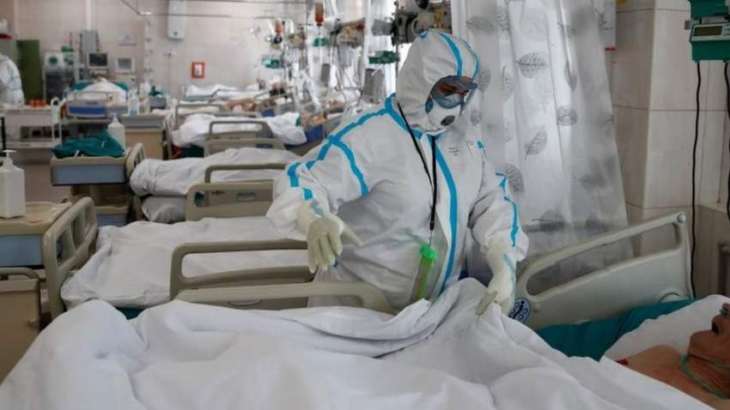As a large number of countries in the northern hemisphere began to face a new wave of massive COVID-19 infections in recent weeks, reintroducing lockdowns without properly tracking and quarantining the infected people and their close contacts is unlikely to curb the transmission of the new virus successfully, public health experts told Sputnik
MOSCOW (Pakistan Point News / Sputnik - 21st October, 2020) As a large number of countries in the northern hemisphere began to face a new wave of massive COVID-19 infections in recent weeks, reintroducing lockdowns without properly tracking and quarantining the infected people and their close contacts is unlikely to curb the transmission of the new virus successfully, public health experts told Sputnik.
After restrictions on social interaction helped bring down COVID-19 infections in the summer, countries in the northern hemisphere, especially a number of European countries, including the United Kingdom, France and Spain, began to experience a resurgence of new cases in recent weeks.
The easing of restrictions appeared to have accelerated the transmission of the deadly virus. Authorities in a number of European countries began to reintroduce the restrictions in response to the latest COVID-19 outbreak.
UK Prime Minister Boris Johnson unveiled a three-tier lockdown system in response to the country's new wave of COVID-19 infections. Authorities in France and Spain also implemented curfews and shut down bars and restaurants as part of their efforts to curb COVID-19 transmissions by restricting social interactions among residents.
However, public health experts pointed out that countries that had prevented a resurgence of COVID-19 outbreaks and sustained their previous containment succeeded because they were able to properly track and quarantine the infected patients and their close contacts.
"Countries still have some elements were very common, in terms of being able to both crush and sustain [low COVID-19 transmission]. One was to focus on case detection, case isolation and especially quarantining of contacts. The continued quarantining and supporting those contacts in their quarantine, not just sending people home," Michael Ryan, Executive Director of the World Health Organization's Health Emergencies Program, said during a press briefing on Monday.
A number of countries in East Asia, including China, Japan and South Korea, have successfully halted local transmission of COVID-19 and avoided a massive wave of new infections.
Public health experts explained why contact tracing is critical in avoiding future waves of COVID-19 infections.
"No country should rely heavily on rolling restrictions. Contact tracing should stay on top of cases so no new waves start. South Korea's second wave was in very specific parts of the community and was contained quickly. Australia and Singapore are the two settings where a substantial second wave with widespread community transmission and both have been fully controlled. Contact tracing should now keep these contained as restrictions are eased in stages," Catherine Bennett, Chair in Epidemiology at the Faculty of Health under the Deakin University in Victoria, Australia, told Sputnik.
The state of Victoria in Australia also experienced a second wave of COVID-19 infections in August, when the daily new cases jumped to over 700. In addition to introducing strict lockdown measures, effective contact tracing and quarantine measures have helped local authorities reduce the number of daily new cases to less than five this week.
"Home isolation mandatory is for all cases, and quarantine for their close contacts and now this is true for the close contacts of this people as well. If the close contact of the case tests negative and hasn't developed symptoms, they can be tested again on day 11 and released from quarantine, along with their own contacts. Anyone who does not want to have the test at day 11 is asked to stay in isolation for a further 10 days, to be safe," Professor Bennett said.
When the Chinese authorities introduced draconian measures to contain the spread of COVID-19 by placing over 59 million people in the Hubei province, where the novel coronavirus behind the pandemic was first detected, under complete lockdown in late January, most other Chinese provinces did not implement similar harsh lockdown measures.
Instead, most Chinese cities, including densely populated metropolises, such as Beijing, Shanghai or Guangzhou, focused on tracking and quarantining people who had returned from the Hubei province during the same period.
Almost everyone who returned from Hubei and their close contacts were placed under a 14-day quarantine. Staff members of the local community committee checked on the returnees from Hubei regularly to see if they were exhibiting flu-like symptoms. Alarms were even installed on the doors of people under quarantine to make sure they did not break the self-isolation requirement.
When a newly infected patient was detected in a city, local authorities would publish details of the patient's address and the places he or she visited recently as part of their measures to trace the person's close contacts. A health code system was also introduced and prohibited close contacts of infected COVID-19 patients from going out and engaging in social interaction.
Similarly, authorities in South Korea deployed contact tracing measures by sending text messages to warn local residents who may have had close contact with infected patients. Digital tools such as smartphone apps were also utilized to help South Korean public health authorities track and trace possible COVID-19 infections.
As a result, efficient contact tracing measures not only helped East Asian countries like China and South Korea contain the first wave of COVID-19 infections in the spring but also allowed those countries to avoid new waves of mass infections by identifying and isolating new cases in a timely manner.
Experiences from fighting previous infectious diseases, such as severe acute respiratory syndrome (SARS) and the Middle East respiratory syndrome (MERS), may have given East Asian countries an advantage in handling the COVID-19 pandemic, public health researchers suggested.
"Largely, Western governments were not prepared for a pandemic in the same way that East Asian countries were. They have witnessed many outbreaks in the past, such as MERS and SARS, and learnt from their previous mistakes. Digital contact tracing was only one aspect in the East Asian response, but it was one that was shown to be very effective. The Western forms of digital contact-tracing were only developed in the middle of the outbreak, with many countries, such as the Netherlands, only releasing their digital contact tracing during their second serious outbreak a few weeks ago," Mark Ryan, a researcher focusing on ethical issues related to artificial intelligence, Big Data, and ICT systems at KTH Royal Institute of Technology in Sweden's city of Stockholm, told Sputnik.
Nevertheless, the researcher noted that stricter privacy laws in the West may have also made contact tracing more challenging.
"Policies such as the GDPR [General Data Protection Regulation in the European Union] and US privacy laws made it difficult to implement digital contact-tracing and slowed down the rapidity at which European countries and the US could deploy these technologies. Many Western countries cherish their freedoms and privacy, so many of the approaches implemented in South Korea or China were initially seen as too harmful to Western standards at the start of the outbreak; although, much of what has consisted of Western countries' lockdowns far surpasses these restrictions, along with huge death-tolls from their slow and cautious responses," Ryan said.
The researcher stressed that governments in different countries need to make sure the digital data collected for contact tracing purposes is properly protected to address the privacy concerns of their citizens.
"In my analysis, I propose that the use of digital contact tracing should be only used for the time that it is needed. However, with pandemics, this time horizon is quite difficult to estimate. I propose one way to do this is provide a specified time-span in which the technology will be used (e.g. 6 months), with a reevaluation of its need at that point in the future. Personal data should be kept to an absolute minimum, if collected at all. All data should be encrypted, anonymized, and secured. Governments need to ensure that their cybersecurity is fit-for-purpose and it is desirable that they have independence from the private sector in the storage, use, and analysis of the data retrieved about their citizens," he said.
COMPLIANCE FROM LOCAL RESIDENTS
At the same time, Ryan pointed out that cultural differences played an important role in whether people complied with the lockdown restrictions and contact tracing requirements.
"Take the use of digital contact tracing in South Korea as another example. Most citizens understood the need for it, its effectiveness at helping control COVID-19, and accepted the trade-off of potential privacy issues, with helping protect their fellow citizens and society as a whole. Culturally, there is a much stronger sense of individualism in the West, where such trade-offs may often be seen as unacceptable," he said.
Compared to people in Europe, local residents in East Asia appeared to be much more willing to comply with contact tracing efforts from local authorities. An infected person usually could name 15 contacts on average in Taiwan, while an infected patient would only identify three contacts in Spain and less than three in France, according to the New York Times.
The researcher admitted that compliance from residents could determine whether authorities could carry out contact tracing and quarantine measures effectively.
"I do not want to say that the control of outbreaks can be controlled by such means alone, and there is certainly a strong element of individual responsibility and social conscience involved for individuals within a country. For example, recently, one individual came back from a holiday to Ireland, did not quarantine, attended parties with friends, close contact with family, played sports, all of which resulted in over 50 confirmed direct cases from that one individual. Perhaps, if there were strict quarantine procedures this individual would not have infected anyone else, but there also needs to be a public acceptance of these policies or else they will backfire on a country because people will reject them or find ways to get around them," he said.
Without sufficient compliance from local residents with contact tracing efforts, Ryan predicted the COVID-19 pandemic could continue throughout the winter and well into the first half of 2021 in Europe.




